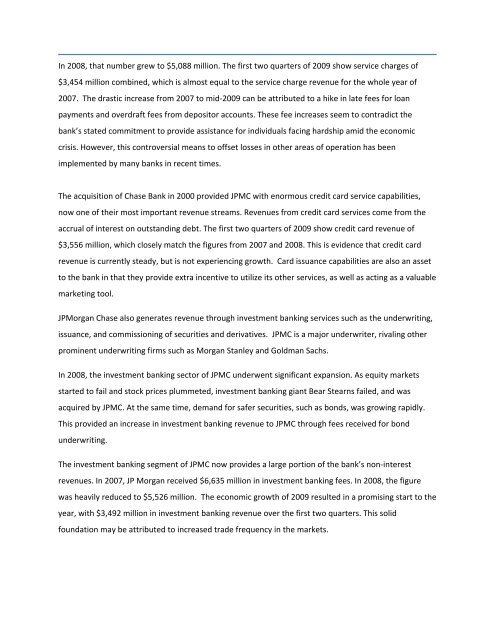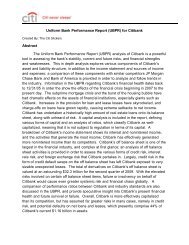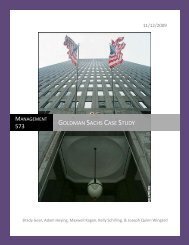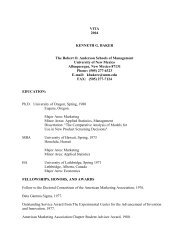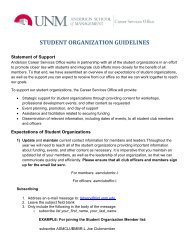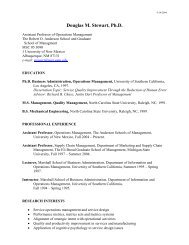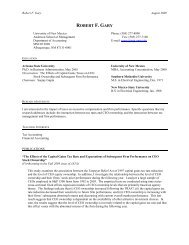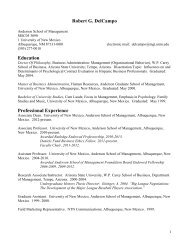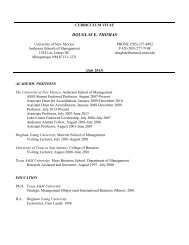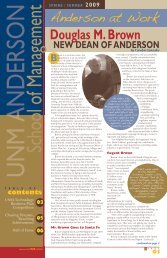Uniform Bank Performance Report - Anderson School of Management
Uniform Bank Performance Report - Anderson School of Management
Uniform Bank Performance Report - Anderson School of Management
You also want an ePaper? Increase the reach of your titles
YUMPU automatically turns print PDFs into web optimized ePapers that Google loves.
In 2008, that number grew to $5,088 million. The first two quarters <strong>of</strong> 2009 show service charges <strong>of</strong><br />
$3,454 million combined, which is almost equal to the service charge revenue for the whole year <strong>of</strong><br />
2007. The drastic increase from 2007 to mid‐2009 can be attributed to a hike in late fees for loan<br />
payments and overdraft fees from depositor accounts. These fee increases seem to contradict the<br />
bank’s stated commitment to provide assistance for individuals facing hardship amid the economic<br />
crisis. However, this controversial means to <strong>of</strong>fset losses in other areas <strong>of</strong> operation has been<br />
implemented by many banks in recent times.<br />
The acquisition <strong>of</strong> Chase <strong>Bank</strong> in 2000 provided JPMC with enormous credit card service capabilities,<br />
now one <strong>of</strong> their most important revenue streams. Revenues from credit card services come from the<br />
accrual <strong>of</strong> interest on outstanding debt. The first two quarters <strong>of</strong> 2009 show credit card revenue <strong>of</strong><br />
$3,556 million, which closely match the figures from 2007 and 2008. This is evidence that credit card<br />
revenue is currently steady, but is not experiencing growth. Card issuance capabilities are also an asset<br />
to the bank in that they provide extra incentive to utilize its other services, as well as acting as a valuable<br />
marketing tool.<br />
JPMorgan Chase also generates revenue through investment banking services such as the underwriting,<br />
issuance, and commissioning <strong>of</strong> securities and derivatives. JPMC is a major underwriter, rivaling other<br />
prominent underwriting firms such as Morgan Stanley and Goldman Sachs.<br />
In 2008, the investment banking sector <strong>of</strong> JPMC underwent significant expansion. As equity markets<br />
started to fail and stock prices plummeted, investment banking giant Bear Stearns failed, and was<br />
acquired by JPMC. At the same time, demand for safer securities, such as bonds, was growing rapidly.<br />
This provided an increase in investment banking revenue to JPMC through fees received for bond<br />
underwriting.<br />
The investment banking segment <strong>of</strong> JPMC now provides a large portion <strong>of</strong> the bank’s non‐interest<br />
revenues. In 2007, JP Morgan received $6,635 million in investment banking fees. In 2008, the figure<br />
was heavily reduced to $5,526 million. The economic growth <strong>of</strong> 2009 resulted in a promising start to the<br />
year, with $3,492 million in investment banking revenue over the first two quarters. This solid<br />
foundation may be attributed to increased trade frequency in the markets.


